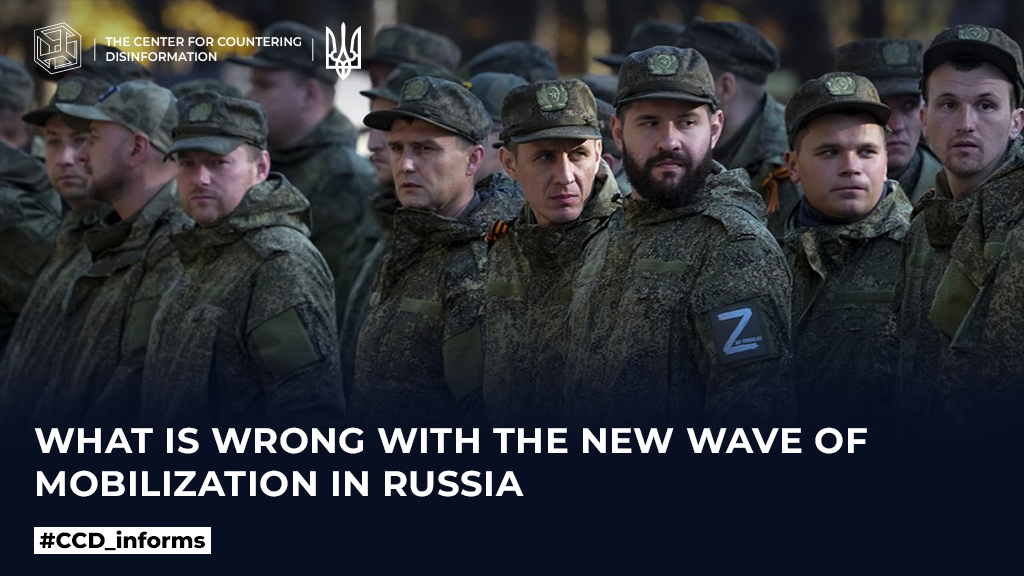It is no secret that during the year of russia-Ukraine war, the russian federation faced significant losses of personnel, which exceeded 238,000 people. According to Forbes, not a single russian remained in Ukraine from those who crossed the border on February 24, 2022.
Already in August 2022, the lack of manpower was so obvious that putin was forced to launch the first wave of so-called partial mobilization. Then the draft did not find support in society and caused a mass flight from russia to one million people. As a result of strict mobilization, approximately 300,000 recruits were enlisted into the ranks of the russian army, which in no way affected the fighting capacity of the russian army, because the newly recruited soldiers turned out to be extremely ineffective on the battlefield. The involvement of colony prisoners for the private military company “wagner” somewhat restrained the crisis phenomena, but these units were most often used as cannon fodder to overwhelm the enemy with numbers. Colossal losses of 30,000 to 40,000 out of 50,000 mobilized prisoners quickly renewed the personnel problem in the russian army. Despite the simplified practice of enlisting recruits from among not only prisoners, but also drug addicts and hepatitis patients, the amount of their recruitment does not keep up with the pace of russian losses at the front.
At the same time, the second negative trend also appeared in the russian army – the participants of the “smo” were artificially divided into the first and second ranks. Some parts of “wagner” returned to Africa, in particular to the Central African Republic, and the rest – to Belarus, where they safely train the Belarusian military. The Chechen formations, removed from the front ostensibly for the protection of the Belgorod region, and in fact for their preservation, are also feeling quite well. While the Ukraine-russia border is protected by border guards, Chechens rest in the most expensive hotels of Belgorod. A nice picture of the participation of Chechen units in battles is created by the “heroes” of propaganda videos – kadyrov officers who command army units of various nationalities (from russians to tuvans and buryats). At the same time, ordinary russian soldiers do not have vacations or rotations from the front line, and honest officers are quickly dismissed for trying to draw attention to their problems. In this way, it was the refusal of the ministry of defense and the general staff of the russian federation to rotate soldiers in the Zaporizhia direction that became the main reason for the protest of the commander of the 58th Army, general popov, which ended in his dismissal.
It is not surprising that russia is struggling to carry out defensive operations in Ukraine, and is simply not ready for offensive ones without additional reinforcements. In fact, the kremlin currently has only two options for the continuation of the war: the use of tactical nuclear weapons or the search for alternative ways to replenish the personnel of the armed forces of the russian federation. The use of tactical nuclear weapons has so far been restrained by the fear of a mirror reaction by NATO countries. The kremlin does not dare to announce another wave of mobilization due to the spread of anti-war sentiments in russian society and unwillingness to sacrifice lives for putin’s ambitious plans in the former “brotherly” country. Moreover, despite the lack of military success in Ukraine, the russian authorities have repeatedly denied plans for a new mobilization.
Therefore, it was decided to go the way of increasing the mobilization reserve by increasing the maximum age of being in the reserve.
On July 14, the state duma of the russian federation adopted the relevant law in the third reading. For conscripts in the ranks of soldiers, sailors, sergeants, foremen, ensigns and midshipmen, the conscription age has been increased from 35 to 40 years, for junior officers – from 50 to 55 years, and for senior officers – from 60 to 65 years. It is worth mentioning here that the russian pension reform launched in 2019 increased the retirement age for men from 60 to 65. So, for a wide category of citizens, the age of being in the reserve practically equaled the retirement age, while the average life expectancy of russian men is 69 years. By the way, the practice of “rowing” everyone “up to 65” to the army, regardless of health status, was previously practiced in the so-called “DNR/LNR”, and now they decided to extend it to the whole of russia.
❗️ Will veiled mobilization in russia change the situation at the front?
The increase in the conscription age indicates huge mobilization problems of the aggressor country. The units that were considered the most motivated and capable of carrying out assault actions “despite the loss” left the Ukrainian front. Attempts to motivate units consisting of ordinary mobilized are doomed to failure. Experts of the American Institute for the Study of War believe that mobilization at the expense of people of pre-retirement age will not be able to seriously affect the fighting ability of russians. The only one who will be happy for the elderly people on the front lines is the pension fund, which will be able to save a lot of money by stopping the payment of pensions to the dead veterans.










